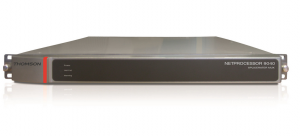
After more than 40 years of operation, DTVE is closing its doors and our website will no longer be updated daily. Thank you for all of your support.
Thomson Video Networks unveils single-feed DVB-T2 and DTH system
 Technology provider Thomson Video Networks has unveiled a new single-feed system for DVB-T2 and DTH satellite networks that it says will enable headend operators to simultaneously feed both types of networks from a single multiplex.
Technology provider Thomson Video Networks has unveiled a new single-feed system for DVB-T2 and DTH satellite networks that it says will enable headend operators to simultaneously feed both types of networks from a single multiplex.
According to Thomson, the system, based on its NetProcessor 9030/40 multiplexing and transport system and RD1100 receiver/descrambler, will enable terrestrial headend operators to perform satellite distribution of SFN multiplexes to transmitters and regionalisation of these multiplexes, as well as the universal coverage via DTH satellite reception now required in many countries.
According to the company, operators can send a multiplex once to feed both DTH receivers and DVB-T2 transmitters, without requiring additional equipment at DVB-T2 transmission sites or extra devices for each transmitter in areas that require regionalisation.
“In many countries, home viewers in white space such as mountainous regions cannot receive digital terrestrial television signals correctly; their only alternative is to receive terrestrial TV via DTH satellite. With our new SingleFeed solution, headend operators can simultaneously feed DTH receivers and DVB-T2 transmitters with a single multiplex, which can result in huge OPEX savings — up to a million euros or the cost of a satellite transponder. Also, SingleFeed is enabling us to respond to the many new DVB-T2 greenfield opportunities, primarily in Africa and Asia, that require this capability,” said Stéphane Cloirec, director of product management, Thomson Video Networks.
“There are similar solutions on the market, but SingleFeed actually represents a first for the industry because it is directly implemented in the DVB-T2 gateway for both the multiplexer and the receiver/descrambler,” Cloirec added. “The solution reinforces Thomson Video Networks’ leadership in the terrestrial headend market and shows our commitment to supporting our customers as new DVB standards emerge.”


